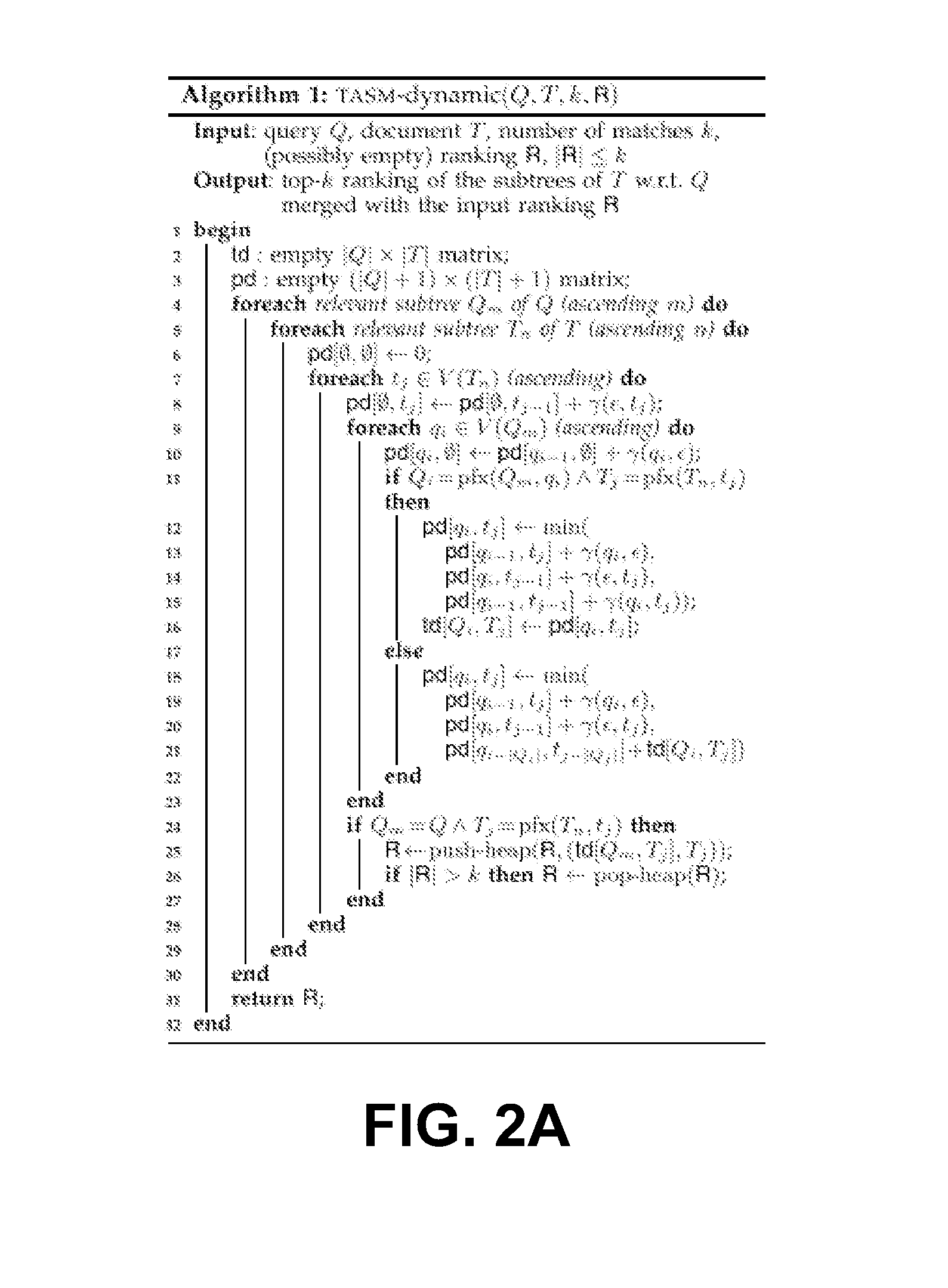SYSTEMS AND METHODS FOR EFFICIENT TOP-k APPROXIMATE SUBTREE MATCHING
a subtree and top-k technology, applied in the field of database computer-based search, can solve the problems of prohibitive o(mn) space complexity and the inability to handle renaming operations in the edit model used to compute distances in xfinder
- Summary
- Abstract
- Description
- Claims
- Application Information
AI Technical Summary
Problems solved by technology
Method used
Image
Examples
example 1
[0094]Consider the example trees in FIG. 1. The relevant subtrees of G are G2 and G3, the relevant subtrees of H are H2, H5, H6, and H7.
[0095]The decomposition rules for the tree edit distance are given in FIG. 2; they decompose the prefixes of two (sub)trees Qm and Tn (qi≦qm, tj≦tn). Rule (e) decomposes two general prefixes, (d) decomposes two prefixes that are proper trees (rather than forests), (b) and (c) decompose one prefix when the other prefix is empty, and (a) terminates the recursion.
[0096]The dynamic programming method for the tree edit distance fills the tree distance matrix td, and the last row of td stores the distances between the query and all subtrees of the document. This yields a simple solution to TASM: compute the tree edit distance between the query and the document, sort the last row of matrix td, and add the k closest subtrees to the ranking. We refer to this method as TASM-dynamic. (See FIG. 2A)
[0097]TASM-dynamic is a dynamic programming implementation of th...
example 2
[0099]TASM-dynamic is computed for (k=2) for query G and document H in FIG. 1 (the cost for all nodes is 1, the input ranking is empty). FIG. 4 shows the prefix and the tree distance matrixes that are filled by TASM-dynamic. Consider, for example, the prefix distance matrix between G3 and H6. The matrix is filled column by column, from left to right. The element pd[g2][h5] stores the distance between the prefixes pfx(G3, g2) and pfx(H6, g5) The upper left element is 0 (Rule (a) in FIG. 2); the first column stores the distances between the prefixes of G3 and the empty prefix and is computed with Rule (b); similarly, the elements in the first row are computed with Rule (c); the shaded cells are distances between proper subtrees and are computed with formula (d); the remaining cells use formula (e). The shaded values of pd are copied to the tree distance matrix td. The two smallest distances in the last row are 0 (column 6) and (column 3), thus the top-2 ranking is R=(H6, H3).
[0100]The...
example 3
[0104]The candidate set of the example document D in FIG. 5a for threshold τ=6 is cand (D, 6)={D5, D7, D12, D17, D21}.
[0105]It should be noted that the candidate set is not the set of all subtrees smaller than threshold τ, but a subset. If a subtree is contained in a different subtree that is also smaller than τ, then it is not in the candidate set. In the dynamic programming approach the distances for all subtrees of a candidate subtree Ti are computed as a side-effect of computing the distance for the candidate subtree Ti. Thus, subtrees of a candidate subtree need no separate computation.
[0106]Explained below is how to compute the candidate set given a size threshold τ for a document represented as a postorder queue. Nodes that are dequeued from the postorder queue are appended to a memory buffer (see FIG. 6) where the candidate subtrees are materialized. Once a candidate subtree is found, it is removed from the buffer, and its tree edit distance to the query is computed.
[0107]Th...
PUM
 Login to View More
Login to View More Abstract
Description
Claims
Application Information
 Login to View More
Login to View More - R&D
- Intellectual Property
- Life Sciences
- Materials
- Tech Scout
- Unparalleled Data Quality
- Higher Quality Content
- 60% Fewer Hallucinations
Browse by: Latest US Patents, China's latest patents, Technical Efficacy Thesaurus, Application Domain, Technology Topic, Popular Technical Reports.
© 2025 PatSnap. All rights reserved.Legal|Privacy policy|Modern Slavery Act Transparency Statement|Sitemap|About US| Contact US: help@patsnap.com



